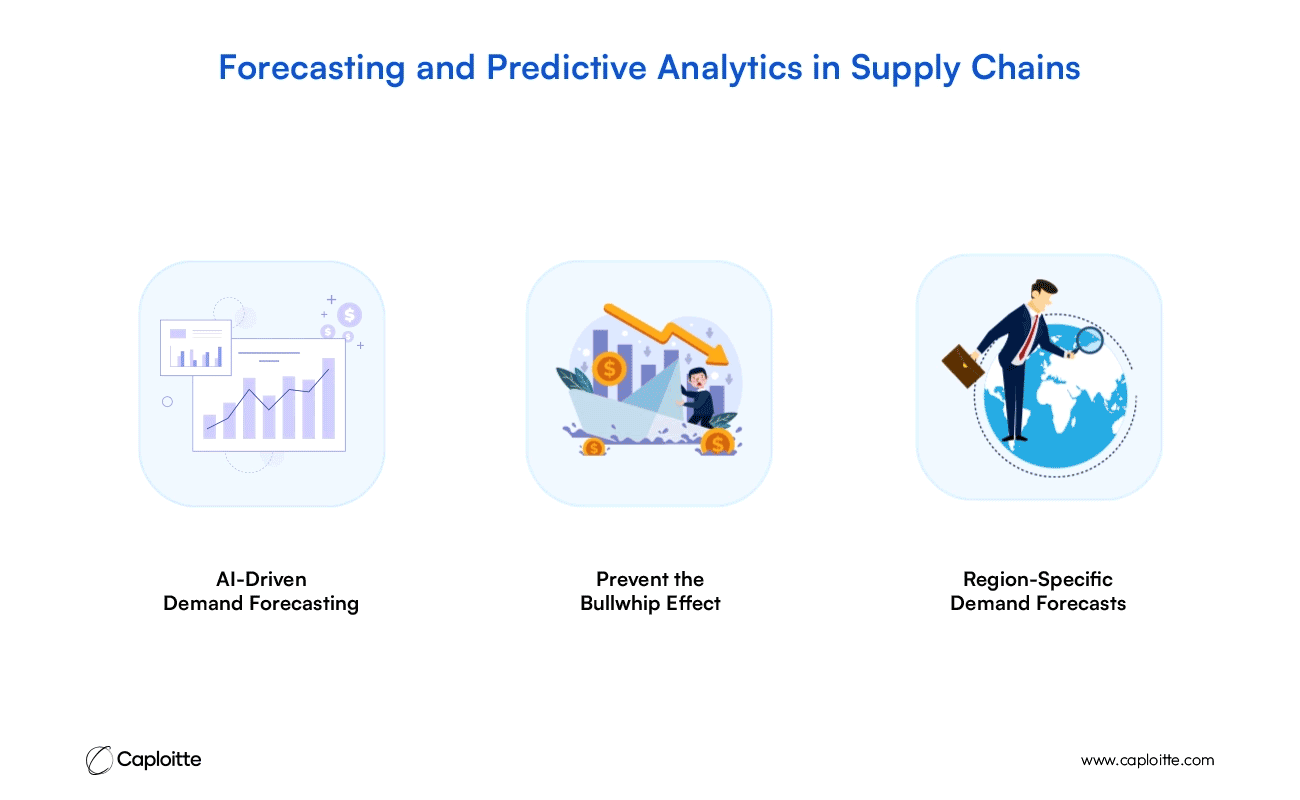How AI and Machine Learning Are Optimizing Supply Chain Efficiency
-
Caploitte
-
16 June 2025
-
05 Min Read
The Critical Role of AI in Modern Supply Chain Management
Forecasting and Predictive Analytics in Supply Chains
How to Prepare the Supply Chains for AI Integration?
Optimizing Inventory Management with the Help of Machine Learning
What are the Challenges in Supply Chain AI Implementation?
Real-World Use Cases and Success Stories
Advanced Applications: Generative AI and Machine Learning
Conclusion
Supply chain management is rapidly evolving due to artificial intelligence (AI). AI is currently being used by businesses to optimize workflows and increase efficiency. AI is becoming a very useful tool for everything from demand forecasting to delivery route optimization. It aids businesses in reducing expenses, increasing productivity, and improving customer satisfaction. In many industries, artificial intelligence (AI) and machine learning (ML) are changing conventional supply chains. Jobs that formerly required hours of manual labor are now automated. AI also enables businesses to anticipate market trends and minimize risks. This change encourages sustainability in addition to efficiency. Artificial intelligence (AI) will continue to influence supply chains as the world gets more digital.
The Critical Role of AI in Modern Supply Chain Management

Supply chain management is changing significantly with the integration of AI. Businesses can increase the speed and efficiency of their processes with its help. Artificial Intelligence (AI) lowers human error and expedites operations by automating manual tasks, lower expenses, and more efficient workflows result from this. AI also enables businesses to foresee issues and respond to them before they arise. This proactive strategy prevents expensive delays and maintains seamless supply chains. AI is now a crucial component of contemporary supply chains in numerous industries.
1. Automation of Operations in the Supply Chain
Numerous repetitive activities in supply chains, such as order processing, paperwork, and billing, are automated by AI. These are labor-intensive and error-prone tasks. Businesses can now do these tasks in a matter of seconds without errors. For instance, UPS employs a system known as ORION that is AI-driven. Real-time delivery route optimization is done by this system. UPS can cut delivery times and save fuel as a result. By reducing emissions, this automation benefits the environment in addition to saving money.
2. Increasing Responsiveness Throughout the Supply Chain
Additionally, supply chain visibility is increased by AI. It offers up-to-date information on logistics, supplier relationships, and inventory. Businesses benefit from this transparency by making better decisions. They are able to forecast inventory needs, track shipments, and keep an eye on supplier performance. Businesses can track products from the warehouse to the customer by combining AI and IoT. Moreover, they can use this data to optimize delivery routes and quickly address any problems. Supply chains are kept flexible and efficient with this degree of visibility.
Forecasting and Predictive Analytics in Supply Chains

The way businesses manage their supply chains is being revolutionized by predictive analytics. Businesses can now anticipate customer demand more precisely than ever before with the help of AI-driven algorithms. By doing this, companies can anticipate market trends and prevent shortages and excess inventory. AI also performs real-time analysis of massive datasets to predict future demand. These insights enable businesses to react swiftly to shifts in the market. Demand forecasting driven by AI is becoming crucial to ensuring seamless operations across all industries.
1. AI-Driven Demand Forecasting
By examining past data, industry trends, and consumer behavior, artificial intelligence (AI) employs machine learning (ML) to forecast consumer demand. This supports businesses in making well-informed decisions about stock levels and production. Walmart, for instance, forecasts product demand and analyzes sales trends using AI. This lowers the possibility of stockouts or overstocking by enabling them to modify their inventory in real-time. For many businesses, the capacity of AI to forecast demand has reduced costs and increased efficiency. It assists in guaranteeing that the appropriate products are accessible when clients require them.
2. Prevent the Bullwhip Effect
The bullwhip effect is the result of minor shifts in customer demand leading to significant changes in the supply chain. This frequently results in expensive overstocking or understocking. AI lessens this impact by supplying precise, up-to-date data. AI assists businesses in avoiding needless inventory buildup by more accurately forecasting demand. It also makes sure businesses don’t run out of inventory during periods of high demand. Customers are happier as a result, and supply chain operations run more smoothly.
3. Region-Specific Demand Forecasts
AI and Machine Learning are also very good at forecasting demand by region. Artificial Intelligence can forecast demand for particular products in various locations by examining regional data. This enables businesses to customize their supply chain plans for every market. For example, a business may keep a larger supply of a product in a location with high demand while keeping a smaller supply in a location with low demand. This localized strategy aids companies in cutting waste and raising customer satisfaction. Because AI can adjust to local trends, businesses can effectively meet customer needs in any market.
How to Prepare the Supply Chains for AI Integration?

Supply chains integrating AI requires careful planning. Businesses need to make sure that their AI initiatives complement their objectives. Data that is well-organized and clean is also necessary for AI algorithms. Finally, it’s critical to choose the appropriate AI tools for given situations. Businesses can maximize the benefits of AI while reducing disruptions with careful planning.
1. Setting Clear Goals for AI Adoption
Businesses must establish specific objectives before deploying AI. These objectives should tackle particular supply chain issues and be in line with the company’s overarching business plans. A business might want to shorten delivery times or increase inventory accuracy, for instance. Businesses can concentrate their AI efforts on resolving the most urgent issues by identifying pain points. This focused strategy guarantees that the use of AI results in quantifiable improvements.
2. Data Preparation and Cleaning
The foundation of AI is data. Businesses need to make sure their data is error-free, well-structured, and clean in order for AI to function efficiently. In this process, redundant or inconsistent data from various sources are sorted and organized. Algorithms using AI can produce precise forecasts and suggestions when given clean data. AI results that aren’t properly prepared for data can be unpredictable and result in bad decisions.
2. Choosing Appropriate AI Technologies
Selecting the appropriate AI tools is necessary for an integration to be successful. Businesses must choose tools that meet their needs because different AI technologies have different uses. For instance, while some businesses may prioritize demand forecasting, others may require logistics optimization. Businesses can guarantee that AI produces the intended outcomes by choosing the appropriate technology. Additionally, careful selection maximizes return on investment while reducing expenses.
Optimizing Inventory Management with the Help of Machine Learning
Building AI is revolutionizing inventory management for businesses. It assists businesses in striking the ideal balance between having an excessive amount or insufficient stock. AI monitors consumer demand and market trends using predictive analytics to maintain precise inventory levels. This results in less waste, fewer shortages, and cheaper expenses. Businesses can now react to market shifts more quickly, guaranteeing they always have the appropriate quantity of stock on hand.
AI-driven inventory optimization enables businesses to keep stock levels in line with current market conditions. It uses extensive data analysis to forecast the amount of stock required at any given time. For instance, machine learning (ML) is used by Amazon to control its inventory. Amazon stays away from overstocking and keeps popular items from running out by doing this. This system guarantees that products are available when customers need them and helps the business stay efficient.
What are the Challenges in Supply Chain AI Implementation?

Businesses Although artificial intelligence (AI) has many advantages, supply chains face difficulties when using it. Businesses need to make sure all of their data is correct and comprehensive. During integration, they must also deal with expensive and intricate logistics. The use of AI too much can cause problems, so human oversight is still essential. In order to safeguard their data and operations, businesses need to take precautions against security risks.
1. Data Accessibility and Quality
Accurate and comprehensive data are essential for AI to function well. AI will yield inaccurate results if the data is faulty. This may result in bad choices and missed chances. Before utilizing AI, businesses need to clean and organize their data. The applications of AI will be limited in the absence of clean data. To ensure AI performs as intended, businesses must therefore give data quality top priority.
2. Cost and Complexity of AI Implementation
Supply chain AI integration can be costly and difficult. Companies frequently need to spend money on staff training and infrastructure upgrades. These expenses can mount up quickly, particularly for big businesses. Furthermore, the setup of AI systems can be time-consuming and interfere with regular business operations. To guarantee a seamless implementation, businesses need to carefully plan and budget for the integration moves.
3. Overuse of artificial intelligence
Even though AI can automate a lot of tasks, it’s important to use it sparingly. Supply chains still require human oversight to be managed efficiently. AI is not a substitute for human judgment, particularly in intricate circumstances. When AI systems malfunction, businesses need qualified experts to take over and fix problems. Supply chains function efficiently when AI and human input are balanced.
4. Risks to Privacy and Security
AI systems are more vulnerable to cyberattacks as they gather more data. Businesses need to make sure that privacy is maintained and that supply chain data is protected from hackers. To prevent breaches, AI systems need to be built with robust security features. Companies should also ensure that they adhere to privacy regulations and be open and honest about how they use data. AI systems pose serious risks to businesses if they are not properly secured.
Real-World Use Cases and Success Stories
AI is having a significant effect on global supply chains. It is being used by industry leaders like UPS and Amazon to increase productivity and customer satisfaction. These practical examples demonstrate how AI-driven solutions can lower expenses, cut waste, and improve operational efficiency.
1. AI-Powered Inventory Management at Amazon
AI is used by Amazon to better manage its inventory. Artificial Intelligence forecasts product demand by examining sales patterns and consumer behavior. By doing this, Amazon is able to maintain the proper level of inventory and prevent stockouts and overstock. Customers receive their products more quickly as a result, and Amazon saves money on needless storage. Because of its AI-driven strategy, Amazon now leads the industry in effective supply chain management.
2. UPS ORION Tool Logistics Optimization
UPS has introduced ORION, an AI-powered system. With the use of this tool, the business can instantly optimize delivery routes. By doing this, UPS lowers its fuel usage and saves money on running expenses. By calculating the optimal routes for drivers, the AI system increases productivity and speed. As a result, UPS makes deliveries more environmentally friendly while also saving money and lowering its carbon footprint.
Advanced Applications: Generative AI and Machine Learning

Supply chain management is changing as a result of generative AI and machine learning (ML). These cutting-edge technologies increase productivity and enable firms to make wiser decisions. They enable businesses to forecast results, find quick fixes for issues, and steer clear of expensive blunders. Supply chains can become more flexible and adaptable by utilizing these technologies.
1. Generative AI in Supply Chain Optimization
Businesses can forecast demand and streamline operations with the aid of new models developed by generative AI. This technology forecasts future needs by analyzing historical data. For instance, BMW manages its inventory of replacement parts using generative AI. BMW saves time and money by doing this to make sure it has the right parts available without overstocking. BMW’s supply chain is kept efficient and decision-making is improved by this sophisticated use of AI.
2. Artificial Intelligence for Predictive Maintenance
AI is essential to predictive maintenance as well. By preventing equipment failures before they occur, it helps businesses save money and minimize downtime. Maersk, for instance, uses IoT and AI to track the state of its cargo. This system can foresee delays and instantly notify the business of any issues. Maersk makes sure its operations function smoothly and prevents expensive disruptions by employing AI for maintenance.
Conclusion
Supply chain management has been progressing and improving swiftly since the introduction of artificial intelligence. It aids businesses in task automation, demand forecasting, and efficiency enhancement. By utilizing technologies such as predictive maintenance and generative AI, companies can steer clear of costly errors and make more informed choices. Artificial Intelligence (AI) will become more and more important in supply chains as technology develops, improving efficiency and sustainability.
Share this post:
Read More
- All
- AI
- AR
- DevOps and CI/CD
- E-commerce
- FinTech
- IoT
- Mobile Development
- Outstaffing
- Security
- SEO
- Tech Trends
- Web Design
- Web Development




